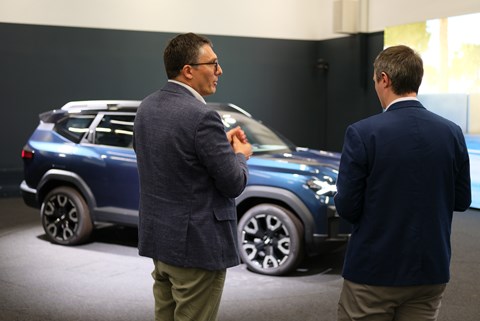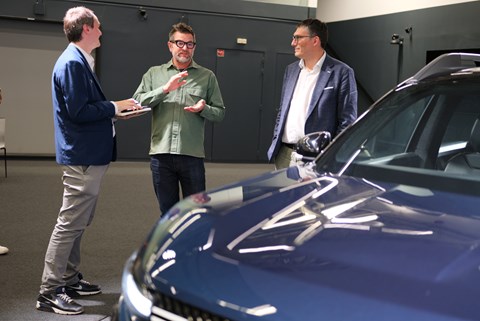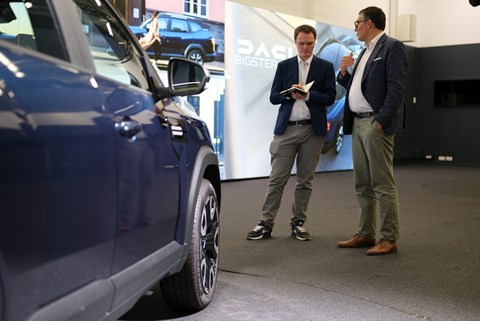► How does Dacia manage to make its cars cheaper?
► CAR meets Dacia’s ‘design-to-cost’ insider team
► Filled with designers and product planners – not accountants
Deep within the bowels of Dacia’s design and engineering offices, a cabal of the brand’s high-ranking executives regularly convene.
But, whether at Renault Group’s evil villain lair-like Technocentre or at Dacia’s super-modern Design Centre in Bucharest, these meetings aren’t about picking the next president or hiding the existence of aliens. Instead, this ‘design-to-cost’ super-group is the key to how Dacia has kept its cars at a distinctly lower price point than many of its competitors.
A handy approach, then, when you sell cars in regions currently being blighted by various cost of living crises. Food, fuel and interest rises (to name just three) have hugely damaged our finances. And that’s before you get to the fact that the ‘cheap’ car as we know it is dead; in 2024, you’ll need £20k just to get a key to a supermini. Want a useful family bus? You’re likely looking at something north of £35k.
And yet… look at Dacia’s new Bigster. Its entry price of £24,995 makes it the cheapest family SUV for the family on sale in the UK – albeit tied with the Chinese-made MG HS – and its flagship model clocks in at under £30k. That sub-£30k price tag for a fully-loaded Bigster includes big car tech like electric seats, a panoramic glass roof, powered tailgate and has a hybrid powertrain.
This isn’t the latest example, either. A Sandero supermini can be had for around £14k. The entry price of the deeply desirable and funky new Duster is £6k less than a much smaller Ford Puma. Similarly priced choices for a seven-seater to a sub-£19k Jogger are lumpy, frumpy vans.

The design-to-cost process is utterly obsessive for those involved. ‘It’s something we do right at the top level,’ says Patrice Levy-Bencheton (pictured above, left), the brand’s product performance vice president and key member of the DTC team. ‘Normally, you would design a part and create a specification for suppliers to run to, and then pick the best part for the lowest price you can. But we do it the other way around – we set a cost, then go to suppliers to see who can match it. We’re fighting for every five or 10 cents, but small rivers help make larger ones.’
But this shadowy supergroup isn’t just there to set challenging supplier targets. Its main role is to meet and discuss new materials and ways of manufacturing parts, or think of methods of how to slim down the number of steps to make them. When they succeed, doing so could save weight, manufacturing time, cost – or any combination of the three.

It’s all very holistic and human. The ideas generated haven’t been the result of some AI algorithm having data fed into it, but of a team of real people that can respond to trends or fresh ideas quickly. ‘We meet every week and it’s quite easy to just sit around the table and discuss ideas,’ David Durand, Dacia’s design chief, tells us. ‘One example is when we decided to stop using chrome in our cars. Chrome used to be used to stop a steel part rusting, but now we just put it on top of plastic which is unnecessary [and bad for the environment]. In a big car company, that decision would have taken two years – we made it in 10 minutes.’
This thinking led to the introduction of the ‘Starkle’ recycled plastic material used since the Manifesto concept of 2022. It’s a durable but cheap material that’s left unpainted, designed to show off its interesting colour and keeping it cheap to make and replace. Since the concept car, Starkle has been deployed on the latest Duster and features on the Bigster.
Other details on the new Bigster are the result of the DTC team’s efforts. Those luxuries like a powered tailgate and electric seats have been given a Dacia onceover; the electric seats still run on manual rails (only reclining and lumbar is electronically controlled), and the tailgate uses just one powered strut rather than two, saving weight and cost. ‘Half the cost, but still 100 per cent of the value,’ smiles Levy-Bencheton.

Bigsters all have LED headlights, ‘but full LED headlights are expensive,’ says Durand (pictured above, centre), ‘so we only give the low beam LED and keep the high beam halogen. That means you get a lower price of the component but keep the cool effect most of the time.’ The rear lighting, meanwhile, has the same smart thinking; ‘we at Dacia never use lights attached to the tailgate,’ says Durand, highlighting the legal requirement to always have visible brake lights even when the tailgate is open. Some car makers get around that by adding extra lighting in other locations, ‘but that means double everything: double the wires, bulbs, LED components… we’ve said no to that,’ he scoffs. ‘We can make a very attractive and robust car with only one set of lamps that stretch out of the body side.’
Then there’s that dual-tone paint colour – usually a step in the manufacturing process that’s slow, expensive and inefficient for most car makers. That doesn’t sound very essential for a brand that’s all about the basics, does it? ‘No, it’s not essential, but we got so much positive feedback from potential customers that we found a great solution,’ says Levy-Bencheton. ‘Usually, the process in the plant would be to paint the body, then to protect all of the lower parts with masking tape done by hand. That takes time and costs a lot because you’re slowing down production…’
‘And you have to heat the paint up twice!’ Durand jumps in. ‘That’s one of the most energy consuming processes in a car factory!’
Instead, Dacia prints the top black layer. Yes: prints it. ‘It’s this new technology we’re introducing that, yes, is a lot like an ink printer,’ smiles Levy-Bencheton. ‘You can be so precise with the pigmentations of the paint with this robot we’re using, and it ends up being more than half the cost of the old way.’

‘It also means just one round of paint protection coating, so you end up with around the same energy consumption as applying a single paint colour,’ adds Durand. ‘It opens up so many possibilities for us.’
Naturally, Dacia’s team hopes that – because of its cost-saving efforts – that means more growth for the brand across Europe. UK figures have already shown that Dacia’s sales have increased by around 10 per cent between 2023 and 2024, up to 31,457 units – that’s set to rise with the launch of the Bigster and two more new models to come. European sales, meanwhile, were up 2.7 per cent in 2024 and the Sandero retained its place as the best-selling car in Europe.
‘[Car] prices have been increasing by around 50 per cent since 2020, but the revenue and purchasing power of the consumer has only increased by 10 per cent,’ says Levy-Bencheton. ‘So, in the end, there’s a real stretch between what they used to be able to get back then and what they can afford today. We intend to provide a new answer and a market for those customers.’